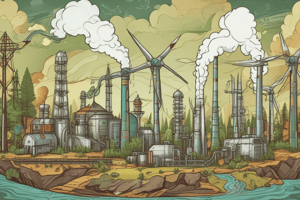Podcast
Questions and Answers
What percentage of the total final energy demand is biomass?
What percentage of the total final energy demand is biomass?
- Between 7% and 27% (correct)
- Less than 5%
- Around 1%
- More than 50%
What is a key characteristic of agricultural biomass?
What is a key characteristic of agricultural biomass?
- Grown only on arable land
- Includes only edible crops
- Only includes permanent pastures
- Includes all agricultural produce, regardless of chemical composition (correct)
What is an advantage of using biomass waste materials?
What is an advantage of using biomass waste materials?
- It increases energy consumption from fossil fuels
- It reduces the value of biomass resources
- It decreases the production of biofuels
- It saves landfill space and increases the value of biomass resources (correct)
What can biomass be converted into in a biorefinery concept?
What can biomass be converted into in a biorefinery concept?
What is an example of dedicated energy crops?
What is an example of dedicated energy crops?
What is the role of sunlight in biomass production?
What is the role of sunlight in biomass production?
Which of the following is NOT a category of biomass?
Which of the following is NOT a category of biomass?
What can be produced from biomass waste materials in a biorefinery?
What can be produced from biomass waste materials in a biorefinery?
What is a key drawback of utilizing forest biomass for energy production, according to the provided content?
What is a key drawback of utilizing forest biomass for energy production, according to the provided content?
Which of these is NOT a benefit of utilizing residual biomass and waste as bioenergy feedstock?
Which of these is NOT a benefit of utilizing residual biomass and waste as bioenergy feedstock?
What does the passage suggest as a solution to the problem of accessing forest biomass for energy production?
What does the passage suggest as a solution to the problem of accessing forest biomass for energy production?
What type of biomass is specifically mentioned as being used in co-combustion with fossil fuels?
What type of biomass is specifically mentioned as being used in co-combustion with fossil fuels?
Which of these is a disadvantage of utilizing residual biomass and waste as bioenergy feedstock?
Which of these is a disadvantage of utilizing residual biomass and waste as bioenergy feedstock?
What is a key challenge in utilizing forest biomass for energy production?
What is a key challenge in utilizing forest biomass for energy production?
Which of the following is NOT a source of by-products, residues, and waste for biomass feedstock, as defined by the FAO (2004)?
Which of the following is NOT a source of by-products, residues, and waste for biomass feedstock, as defined by the FAO (2004)?
What is the primary method for converting forest biomass into usable energy, as described in the passage?
What is the primary method for converting forest biomass into usable energy, as described in the passage?
What is the main factor that hinders the widespread adoption of energy crops for large-scale biofuel production?
What is the main factor that hinders the widespread adoption of energy crops for large-scale biofuel production?
Which of the following is NOT a characteristic that makes aquatic biomass, particularly algae, a promising renewable feedstock for biofuel production?
Which of the following is NOT a characteristic that makes aquatic biomass, particularly algae, a promising renewable feedstock for biofuel production?
What is a significant difference between lignocellulosic biomass and aquatic biomass, specifically algae, in terms of their composition?
What is a significant difference between lignocellulosic biomass and aquatic biomass, specifically algae, in terms of their composition?
What is the primary advantage of using algae as a feedstock for biofuel production compared to traditional energy crops?
What is the primary advantage of using algae as a feedstock for biofuel production compared to traditional energy crops?
What is an example of wet waste biomass that can be used as a feedstock for biofuel production?
What is an example of wet waste biomass that can be used as a feedstock for biofuel production?
What is the main challenge associated with the large-scale production of biofuels from energy crops?
What is the main challenge associated with the large-scale production of biofuels from energy crops?
Which of the following is NOT a factor that needs to be considered for the successful implementation of energy crops?
Which of the following is NOT a factor that needs to be considered for the successful implementation of energy crops?
What is the estimated land area required for energy crop cultivation in the most likely scenario, as mentioned in the text?
What is the estimated land area required for energy crop cultivation in the most likely scenario, as mentioned in the text?
Flashcards are hidden until you start studying
Study Notes
Biomass Energy Overview
- Biomass energy, particularly in modern forms, could significantly impact the energy sector, agriculture modernization, and rural development.
- Biomass contributes to 7% to 27% of total final energy demand.
Biomass Production and Sources
- Biomass includes all organic material, such as living plants, waste plant forms, and animal waste.
- Categories of biomass:
- Waste materials (agricultural and forest residues, municipal solid waste, food processing waste).
- Dedicated energy crops.
Benefits of Biomass Waste
- Biomass waste can provide a valuable bioenergy source when effectively harnessed.
- Utilization of biomass waste helps reduce energy consumption from fossil fuels, saves landfill space, and enhances biomass resource value.
Agricultural Biomass
- Refers to biomass from agricultural land, including various crops, regardless of their chemical composition.
- Encompasses primary sources like sugarcane and energy plantations.
Forest Biomass Utilization
- Direct combustion of forest biomass can generate energy, emitting less CO2 compared to fossil fuels.
- Challenge includes accessing forest resources due to their vastness and complexity, necessitating industries to be located within a 120 km radius of forests for sustainability.
By-products and Residual Biomass
- Defined as biomass from side streams in agricultural, forestry, and related industrial operations.
- Benefits include reduced pollution, lower production costs, and decreased transportation costs.
- Drawbacks include price volatility, uncertain long-term supply, competition for raw materials, and potential soil depletion.
Energy Crops
- New farming practices involving dedicated energy crops and intercropping.
- Factors influencing energy crop cultivation include land availability, food versus fuel conflicts, climate conditions, and investment costs.
Aquatic Biomass
- Comprises plant and animal materials formed in water, like algae and seaweed.
- Algae can thrive in various water types, including wastewater, making them a promising biomass feedstock.
- Higher photosynthetic efficiency allows for greater biomass production and reduced greenhouse gas emissions by up to 90%.
- Algae's composition differs from lignocellulosics, being richer in carbohydrates, proteins, and lipids.
Studying That Suits You
Use AI to generate personalized quizzes and flashcards to suit your learning preferences.





